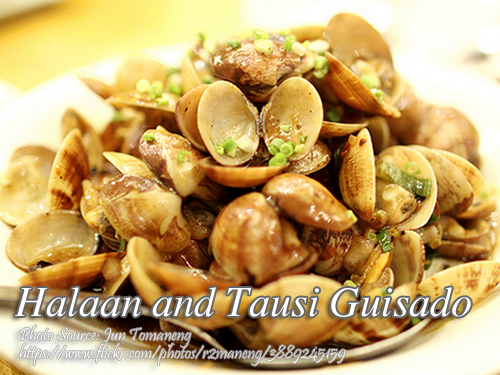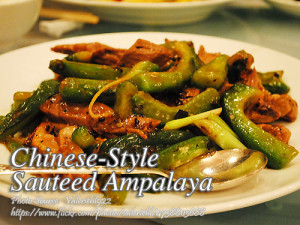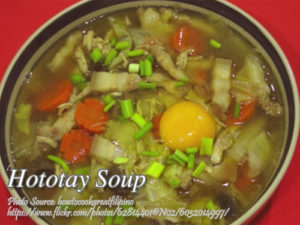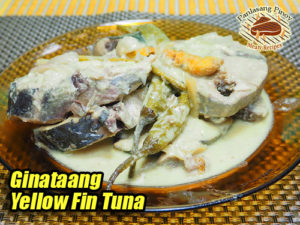This halaan guisado with tausi recipe is actually sauteed clams with salted black beans. Sauteing or stir frying is a usual way of cooking with Chinese cuisine and not to mention, the salted black beans. Salted black beans has a distinct flavor compared to salted yellow beans although they might be similar, it will not taste as good as the black beans. Anyway you can experiment if your local grocery store or supermarket ran out of stock and your only choice is to get a substitute.
Halaan Guisado with Tausi: A Hearty Dish from the Sea
I still remember the first time I had halaan guisado with tausi. It was during a visit to my Uncle Rodel’s home in Batangas, a province known for its fresh seafood and bold flavors. He was a firm believer that no dish could go wrong with a generous helping of garlic and ginger, and true enough, his version of this classic seafood dish was unforgettable.
The Magic of Salted Black Beans
Halaan, or clams, are widely used in Filipino cuisine, often cooked in a comforting soup like halaan sa luya, but when stir-fried with tausi (salted black beans), they take on an entirely new personality. This technique, heavily influenced by Chinese cooking, brings out a deeper umami taste that complements the natural brininess of the shellfish. My Aunt Celia always told me that while salted yellow beans could be a substitute, they never quite captured the same complexity as black beans. And I had to agree—the rich, slightly fermented flavor of tausi added a depth that made the dish irresistibly good.
Why Soak the Clams?
Before anything else, my cousin Lando insisted that the clams needed to be soaked in water for several hours. As a kid, I never understood why this step was necessary, but as I grew older, I realized it was crucial. Clams tend to carry sand and other particles from the ocean floor, and giving them enough time to purge ensures that every bite is clean and free from any unpleasant grittiness. Soaking them for at least four hours, or even overnight, in lightly salted water does wonders in keeping the dish smooth and enjoyable.
The Perfect Stir-Fry
Once the clams were properly cleaned, Uncle Rodel would fire up his small carajay (wok) and heat some oil. The fragrance of garlic, ginger, and chili quickly filled the kitchen, instantly making everyone hungry. He explained that this step was key—sautéing these aromatics before adding the main ingredients builds a solid flavor base. The ginger, in particular, helped neutralize any overly fishy taste while also adding warmth to the dish.
A simple mixture of cornstarch and water was then poured into the wok, allowing it to thicken slightly before the clams were added. As the shells slowly opened, releasing their natural juices into the sauce, the real magic happened. The combination of seafood essence and seasoned black beans created a rich, savory glaze that coated the clams beautifully. A small pinch of sugar was tossed in at the last minute—just enough to balance out the saltiness of the tausi without making the dish sweet.
Halaan Guisado: A Dish Best Served Fresh
When the final ingredient, a handful of freshly chopped leeks, was thrown in, I knew it was time to eat. My uncle always served his guisadong halaan straight from the pan, still sizzling, with a side of steaming hot rice. The contrast of flavors—the mild sweetness of the clams, the salty kick of the black beans, and the subtle heat from the ginger and chili—made every bite utterly satisfying.
I quickly learned that this dish is best enjoyed fresh. Clams have a delicate texture that can turn rubbery if overcooked or left sitting too long. So whenever I make this dish at home, I gather everyone around the table before it even leaves the stove, just like my family used to do.
A Taste of Tradition
Halaan guisado with tausi may have a touch of Chinese influence, but it remains deeply Filipino at heart. It embodies the resourcefulness of Filipino cooking—taking humble ingredients and transforming them into something hearty and flavorful. Whether you’re cooking for a special gathering or just craving a comforting seafood dish, this is a recipe worth keeping in your repertoire.
The next time you visit the market, don’t overlook those fresh clams. Bring home a batch, soak them well, and give this dish a try. Who knows? It might just become your family’s next favorite, just as it did for mine.
How to Cook Halaan and Tausi Guisado
Ingredients
- 2 kilos live halaan or clams
- 1 Tbsp. sesame oil
- 1 Tbsp. garlic crushed
- 2 Tbsp. ginger chopped
- 1 pc red chili or siling labuyo seeded and finely chopped
- 2 Tbsp. cornstarch dissolved in 1/4 cup water
- 1 tsp. sugar
- 1/4 cup tausi or salted black beans
- 2 to 3 stems onion leeks cut into 1 inch long
Instructions
How to cook Halaan and Tausi Guisado:
- Soak the live clams in water for about 4 hours to spit the sand and other particles.
- Then wash thoroughly and set aside.
- Heat oil in a frying pan (or small carajay or wok) over medium heat.
- Add in garlic, ginger and chili. Saute for 1 minute or until fragrant.
- Pour in the cornstarch and water mixture and let it boil.
- Add the clams and simmer until the shells are opened. Add sugar and tausi.
- Add in leeks and stir cook lightly until done. Serve hot.
Notes
Cooking Tips:
Soak Clams Properly for a Grit-Free Dish
Before cooking halaan guisado, always soak the clams in water for at least four hours to help them expel sand and other impurities. Adding a bit of salt to the water can speed up the purging process, ensuring a cleaner and more enjoyable dish. Rinse them thoroughly afterward to remove any remaining grit before cooking.Sauté Aromatics First for Depth of Flavor
Cooking garlic, ginger, and chili in hot oil before adding the clams enhances the overall taste of the dish. This step releases essential oils and deepens the umami flavors, creating a rich, fragrant base. Ginger, in particular, helps counteract any overly fishy taste, making the clams taste fresher.Avoid Overcooking the Clams for Perfect Texture
Clams cook quickly and should be removed from heat as soon as they open, usually within a few minutes. Overcooking makes them rubbery and tough, diminishing their natural sweetness. If some shells remain closed, discard them as they may not be safe to eat.





